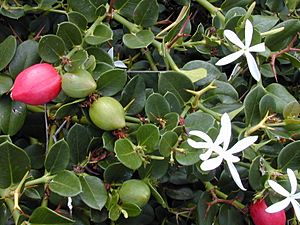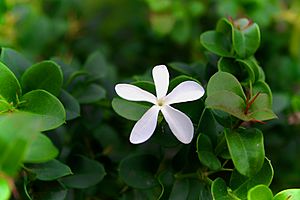Natal plum facts for kids
Quick facts for kids Natal plum |
|
|---|---|
 |
|
| Conservation status | |
| Scientific classification | |
| Genus: |
Carissa
|
| Species: |
macrocarpa
|
| Synonyms | |
|
Carissa grandiflora (E.Mey.) A.DC. |
|
| Nutritional value per 100 g (3.5 oz) | |
|---|---|
| Energy | 259 kJ (62 kcal) |
|
13.63 g
|
|
|
1.3 g
|
|
|
Protein
|
0.5 g
|
| Vitamins | Quantity
%DV†
|
| Thiamine (B1) |
3%
0.04 mg |
| Riboflavin (B2) |
5%
0.06 mg |
| Niacin (B3) |
1%
0.2 mg |
| Vitamin C |
46%
38 mg |
| Minerals | Quantity
%DV†
|
| Calcium |
1%
11 mg |
| Iron |
10%
1.31 mg |
| Magnesium |
5%
16 mg |
| Phosphorus |
1%
7 mg |
| Potassium |
9%
260 mg |
| Sodium |
0%
3 mg |
| Other constituents | Quantity |
| Water | 84.17 g |
|
Link to USDA Database entry
|
|
| †Percentages estimated using US recommendations for adults. | |
The Carissa macrocarpa is a type of shrub that grows naturally in warm, tropical parts of southern Africa. It is often called the Natal plum. In South Africa, people also know it as the large num-num. The Zulu people and other tribes in Uganda call it Amathungulu or umThungulu oBomvu. In Afrikaans, the fruit is known as noem-noem.
This plant is great at handling salty winds, which makes it a good choice for growing near the coast. You can often find it in the coastal areas of the Eastern Cape and Natal in South Africa. It has shiny, dark green leaves and pretty white flowers. These flowers smell even stronger and sweeter at night. Like other Carissa plants, the Natal plum is a spiky, evergreen shrub. It also has a milky sap called latex.
The Natal plum blooms for many months. Its round, bright red fruits appear in summer and fall, often at the same time as the flowers. In places with mild coastal weather, the fruits can even appear all year round. You can eat the fruit fresh, or use it to make delicious pies, jams, jellies, and sauces. While some people think other parts of the plant are poisonous, this is mostly a myth. The University of California, Davis, says the plant is only mildly toxic. The Natal plum is listed as number 640.3 on the South African National tree list.
This fruit is a traditional food in Africa. It has the potential to help improve nutrition, make sure people have enough food, and support farming in rural areas.
Contents
Where Natal Plums Grow
The Carissa macrocarpa mostly grows along the coasts of South Africa. You can find it on sand dunes and at the edges of coastal forests. It grows from the Eastern Cape up to Natal and Mozambique. This plant also grows in Zambia, Zimbabwe, and further north in the Democratic Republic of the Congo and Kenya. Today, the Natal plum is also common in southern Florida. People grow it in southern California and use it as a decorative plant in Central America and the Caribbean.
Growing Natal Plums
Starting New Plants
The Carissa macrocarpa is quite easy to grow. Its seeds usually sprout two to four weeks after you plant them. The young plants grow slowly at first. Plants grown from seeds will start to produce fruit within their first two years.
It is also possible to grow new plants from parts of an existing plant. This method is often preferred. One good way is to cut young branches halfway through. Then, you bend them downwards so they hang loosely. After about two months, the cut part will form a hard protective layer. At this point, you can remove the cutting from the main plant. Plant it in sand in a partly shaded spot. Roots will grow within one month. Using this method, Carissa macrocarpa plants will also produce fruits within their first two years.
Caring for Natal Plums
Taking care of the Carissa macrocarpa is simple. Since it is native to South Africa, it usually does not need any special fertilizer.
How Flowers Make Fruit
In its home country, Carissa macrocarpa flowers are pollinated by insects that fly at night. These flowers have both male and female parts. Outside of its native area, sometimes the plants do not produce fruit because there are not enough insects to pollinate them. However, people can pollinate the flowers by hand. In the future, growers might be able to develop types of Natal plum flowers that can pollinate themselves more easily.
Planting and Pruning
Because Natal plum bushes have sharp thorns, it is best to plant them in narrow hedges. This makes it much easier to reach the fruits, which grow on top of the bush. Trimming the plant, called pruning, is helpful. It encourages the bush to grow more tips that will produce fruit. Besides this, you do not need to do much pruning to keep the bush from growing too big. This also helps the plant produce more fruits.
Picking the Fruit
Natal plum plants can produce a lot of fruit. In South Africa, commercial farms can get at least 3 tons of fruit from one hectare of land. The main time for fruit production is in the summer, but the fruits ripen at slightly different times. This means each fruit must be picked when it is perfectly ripe. If the growing conditions are good, the plant also produces many fruits during the off-season. When harvesting, you need to be careful with the skin of the ripe fruits. It can bruise easily and the fruits spoil quickly.
Different Types of Natal Plums
Scientists who study plants in South Africa and the USA (Florida and California) have found and named several types of Carissa plants. These types tend to produce fruit more reliably. Their fruits are often larger, have a good texture, and contain fewer seeds. In California, some popular types are Fancy (which has many large fruits with few seeds), Torrey Pines (known for good fruit production and lots of pollen), Frank (good for pollen but does not produce many fruits itself), Chelsey, and Serena. In Florida, Gifford is one of the best fruit producers. In Africa, C. haematocarpa is good for drier areas, and C. bispinosa grows well in higher places.
Where Natal Plums Like to Grow
The Carissa macrocarpa needs a warm, moist, subtropical climate. It can grow in different light conditions, from full sun to quite a lot of shade. Since it is a coastal plant, it can handle salty ocean spray very well.
| Factor | What it Needs |
|---|---|
| Rainfall | Up to 1000 mm (about 40 inches) of rain per year |
| Drought | It can handle dry periods and does not need watering in summer rainfall areas |
| Altitude | Grows up to 1000 meters (about 3,300 feet) above sea level; possibly up to 1500 meters (about 4,900 feet) |
| Cold | Can handle cold down to -5 °C (23 °F); young plants need protection |
| Warmth | Grows well up to 32 °C (90 °F) in the shade; grows best in full sun |
| Soil | Any type of soil (like limestone, heavy clay, or sand) as long as water drains well |
| Salinity | Can handle salty conditions (up to 5000 parts per million) |
See also
 In Spanish: Ciruela de Natal para niños
In Spanish: Ciruela de Natal para niños




